Attached files
| file | filename |
|---|---|
| 8-K - 8-19-2015 USDP 8-K - USD Partners LP | a8-19x2015usdp8xk.htm |
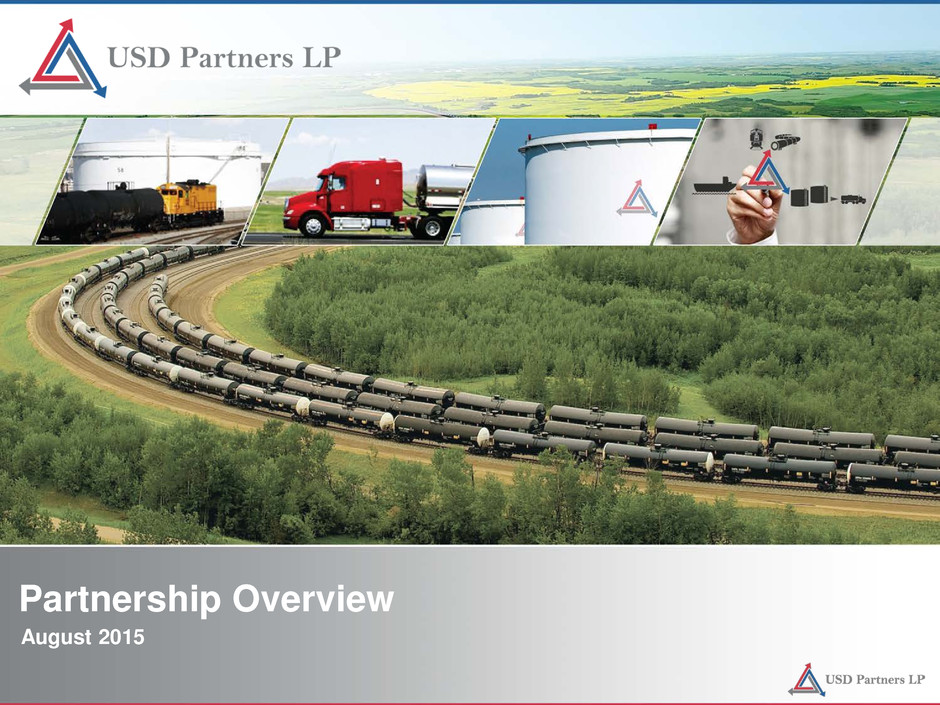
August 2015 Partnership Overview
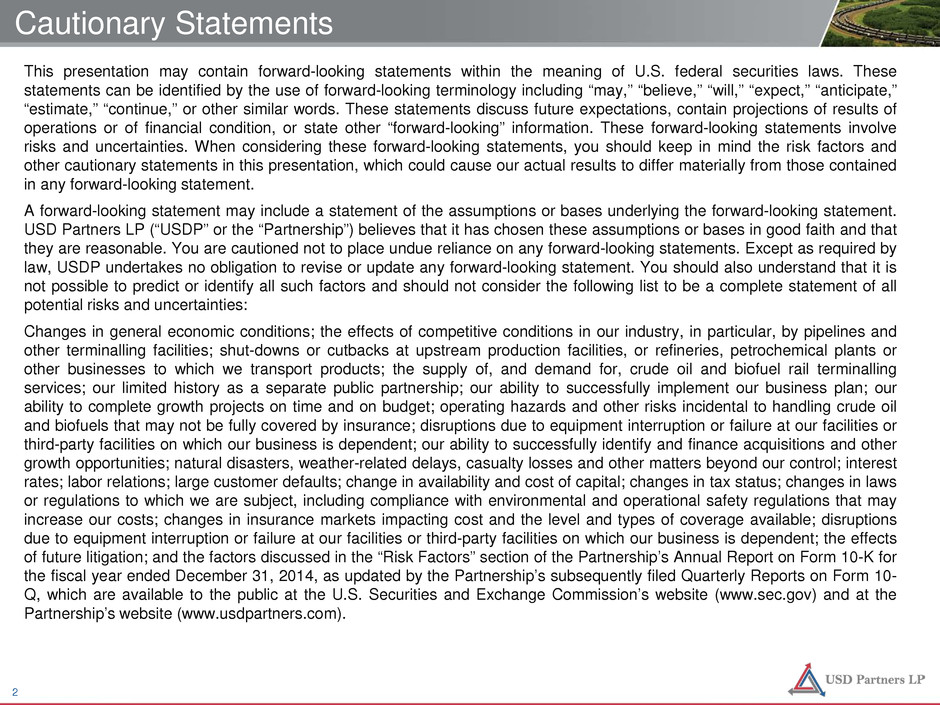
Cautionary Statements This presentation may contain forward-looking statements within the meaning of U.S. federal securities laws. These statements can be identified by the use of forward-looking terminology including “may,” “believe,” “will,” “expect,” “anticipate,” “estimate,” “continue,” or other similar words. These statements discuss future expectations, contain projections of results of operations or of financial condition, or state other “forward-looking” information. These forward-looking statements involve risks and uncertainties. When considering these forward-looking statements, you should keep in mind the risk factors and other cautionary statements in this presentation, which could cause our actual results to differ materially from those contained in any forward-looking statement. A forward-looking statement may include a statement of the assumptions or bases underlying the forward-looking statement. USD Partners LP (“USDP” or the “Partnership”) believes that it has chosen these assumptions or bases in good faith and that they are reasonable. You are cautioned not to place undue reliance on any forward-looking statements. Except as required by law, USDP undertakes no obligation to revise or update any forward-looking statement. You should also understand that it is not possible to predict or identify all such factors and should not consider the following list to be a complete statement of all potential risks and uncertainties: Changes in general economic conditions; the effects of competitive conditions in our industry, in particular, by pipelines and other terminalling facilities; shut-downs or cutbacks at upstream production facilities, or refineries, petrochemical plants or other businesses to which we transport products; the supply of, and demand for, crude oil and biofuel rail terminalling services; our limited history as a separate public partnership; our ability to successfully implement our business plan; our ability to complete growth projects on time and on budget; operating hazards and other risks incidental to handling crude oil and biofuels that may not be fully covered by insurance; disruptions due to equipment interruption or failure at our facilities or third-party facilities on which our business is dependent; our ability to successfully identify and finance acquisitions and other growth opportunities; natural disasters, weather-related delays, casualty losses and other matters beyond our control; interest rates; labor relations; large customer defaults; change in availability and cost of capital; changes in tax status; changes in laws or regulations to which we are subject, including compliance with environmental and operational safety regulations that may increase our costs; changes in insurance markets impacting cost and the level and types of coverage available; disruptions due to equipment interruption or failure at our facilities or third-party facilities on which our business is dependent; the effects of future litigation; and the factors discussed in the “Risk Factors” section of the Partnership’s Annual Report on Form 10-K for the fiscal year ended December 31, 2014, as updated by the Partnership’s subsequently filed Quarterly Reports on Form 10- Q, which are available to the public at the U.S. Securities and Exchange Commission’s website (www.sec.gov) and at the Partnership’s website (www.usdpartners.com). 2
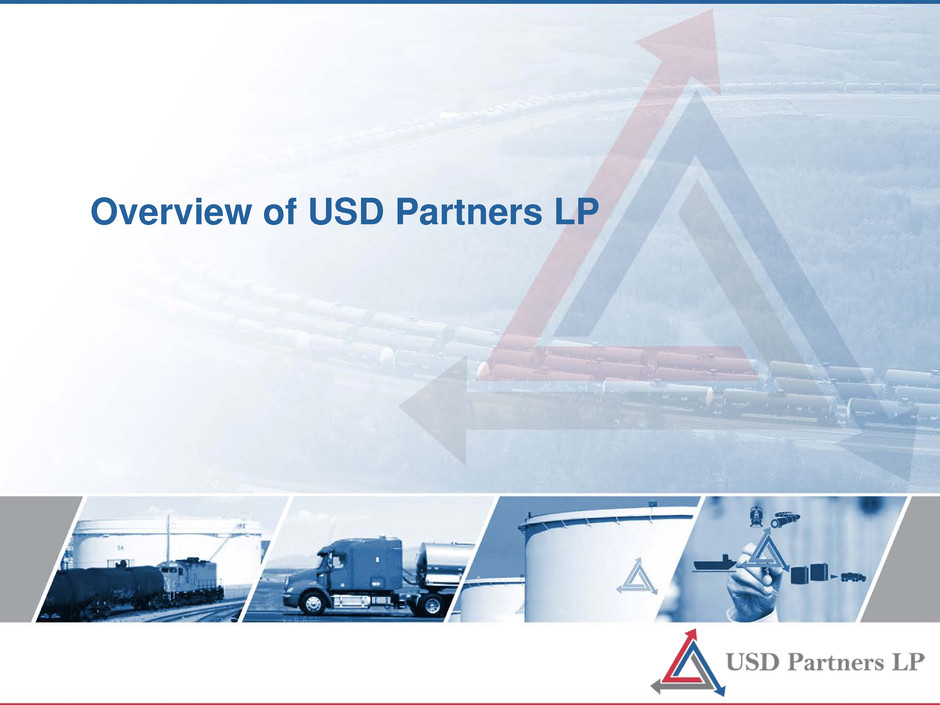
Overview of USD Partners LP
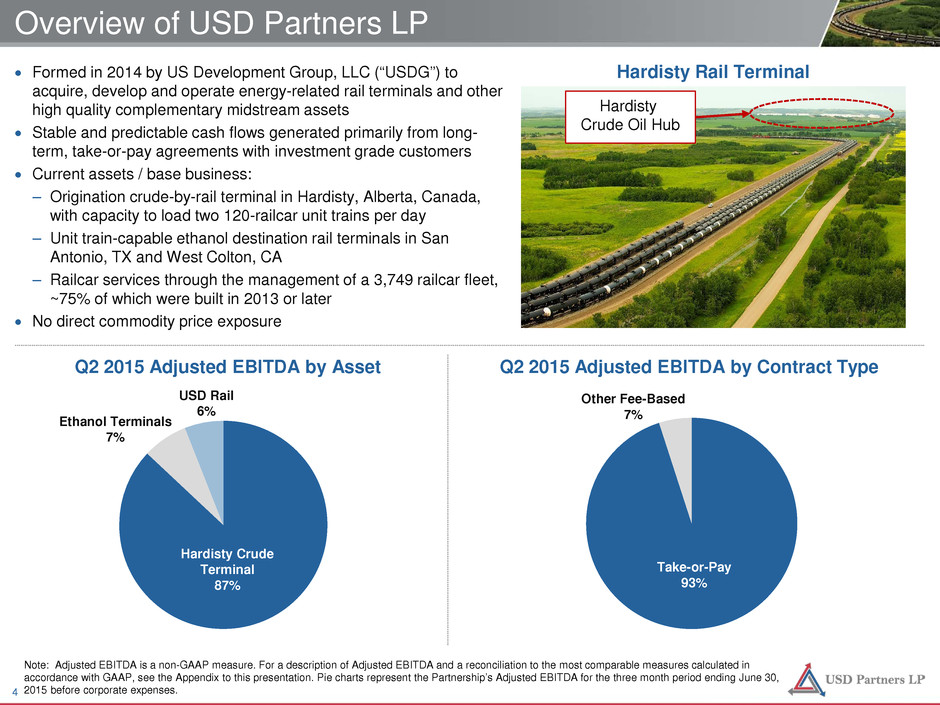
Overview of USD Partners LP Hardisty Rail Terminal Hardisty Crude Oil Hub • Formed in 2014 by US Development Group, LLC (“USDG”) to acquire, develop and operate energy-related rail terminals and other high quality complementary midstream assets • Stable and predictable cash flows generated primarily from long- term, take-or-pay agreements with investment grade customers • Current assets / base business: – Origination crude-by-rail terminal in Hardisty, Alberta, Canada, with capacity to load two 120-railcar unit trains per day – Unit train-capable ethanol destination rail terminals in San Antonio, TX and West Colton, CA – Railcar services through the management of a 3,749 railcar fleet, ~75% of which were built in 2013 or later • No direct commodity price exposure Q2 2015 Adjusted EBITDA by Asset USD Rail 6% Ethanol Terminals 7% Q2 2015 Adjusted EBITDA by Contract Type Other Fee-Based 7% Take-or-Pay 93% Hardisty Crude Terminal 87% Note: Adjusted EBITDA is a non-GAAP measure. For a description of Adjusted EBITDA and a reconciliation to the most comparable measures calculated in accordance with GAAP, see the Appendix to this presentation. Pie charts represent the Partnership’s Adjusted EBITDA for the three month period ending June 30, 2015 before corporate expenses.4
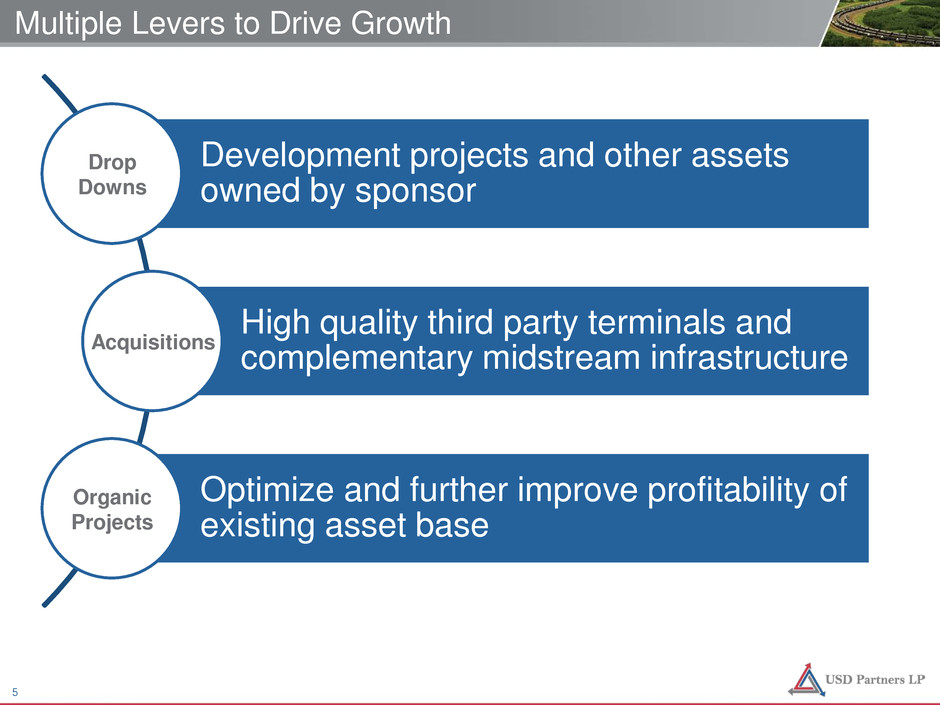
Multiple Levers to Drive Growth Development projects and other assets owned by sponsor High quality third party terminals and complementary midstream infrastructure Optimize and further improve profitability of existing asset base Drop Downs Acquisitions Organic Projects 5
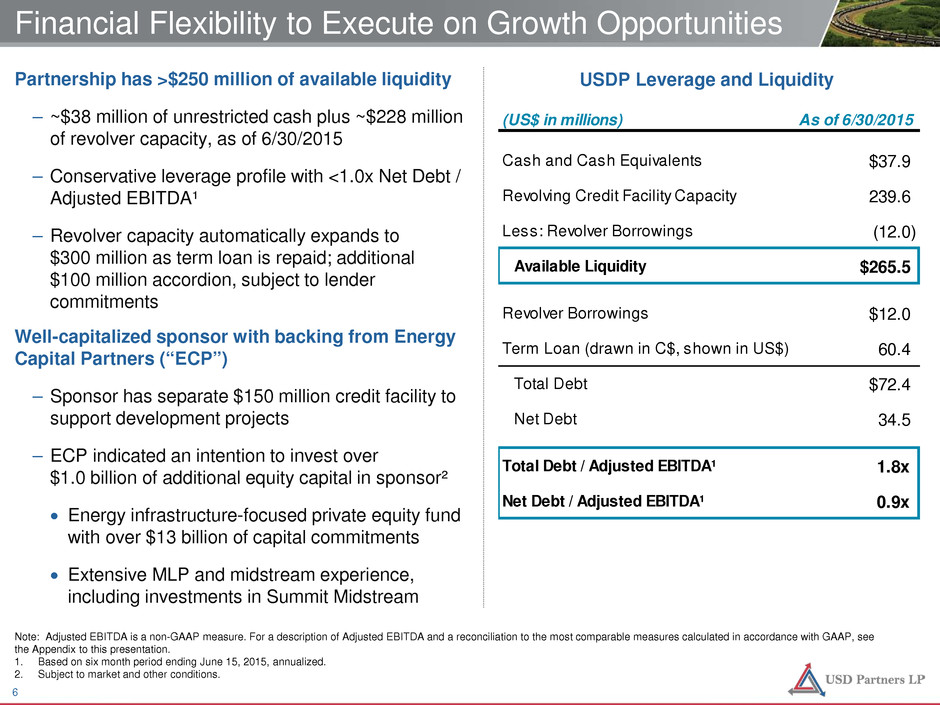
Partnership has >$250 million of available liquidity – ~$38 million of unrestricted cash plus ~$228 million of revolver capacity, as of 6/30/2015 – Conservative leverage profile with <1.0x Net Debt / Adjusted EBITDA¹ – Revolver capacity automatically expands to $300 million as term loan is repaid; additional $100 million accordion, subject to lender commitments Well-capitalized sponsor with backing from Energy Capital Partners (“ECP”) – Sponsor has separate $150 million credit facility to support development projects – ECP indicated an intention to invest over $1.0 billion of additional equity capital in sponsor² • Energy infrastructure-focused private equity fund with over $13 billion of capital commitments • Extensive MLP and midstream experience, including investments in Summit Midstream Financial Flexibility to Execute on Growth Opportunities USDP Leverage and Liquidity Note: Adjusted EBITDA is a non-GAAP measure. For a description of Adjusted EBITDA and a reconciliation to the most comparable measures calculated in accordance with GAAP, see the Appendix to this presentation. 1. Based on six month period ending June 15, 2015, annualized. 2. Subject to market and other conditions. (US$ in millions) As of 6/30/2015 Cash and Cash Equivalents $37.9 Revolving Credit Facility Capacity 239.6 Less: Revolver Borrowings (12.0) Available Liquidity $265.5 Revolver Borrowings $12.0 Term Loan (drawn in C$, shown in US$) 60.4 Total Debt $72.4 Net Debt 34.5 Total Debt / Adjusted EBITDA¹ 1.8x Net Debt / Adjusted EBITDA¹ 0.9x 6
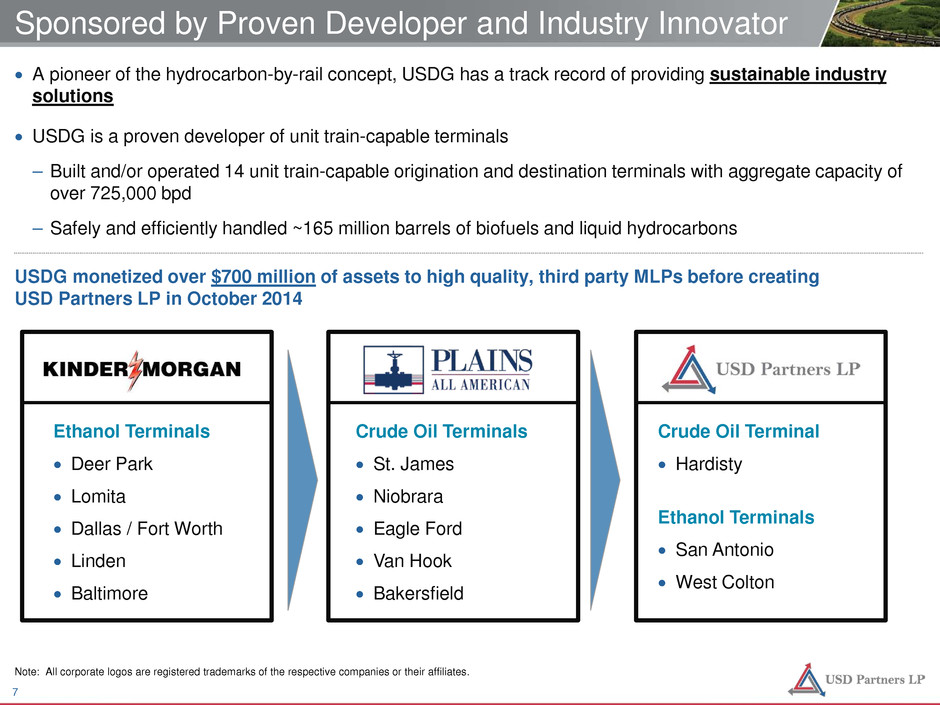
• A pioneer of the hydrocarbon-by-rail concept, USDG has a track record of providing sustainable industry solutions • USDG is a proven developer of unit train-capable terminals – Built and/or operated 14 unit train-capable origination and destination terminals with aggregate capacity of over 725,000 bpd – Safely and efficiently handled ~165 million barrels of biofuels and liquid hydrocarbons Sponsored by Proven Developer and Industry Innovator USDG monetized over $700 million of assets to high quality, third party MLPs before creating USD Partners LP in October 2014 Ethanol Terminals • Deer Park • Lomita • Dallas / Fort Worth • Linden • Baltimore Crude Oil Terminals • St. James • Niobrara • Eagle Ford • Van Hook • Bakersfield Crude Oil Terminal • Hardisty Ethanol Terminals • San Antonio • West Colton Note: All corporate logos are registered trademarks of the respective companies or their affiliates. 7
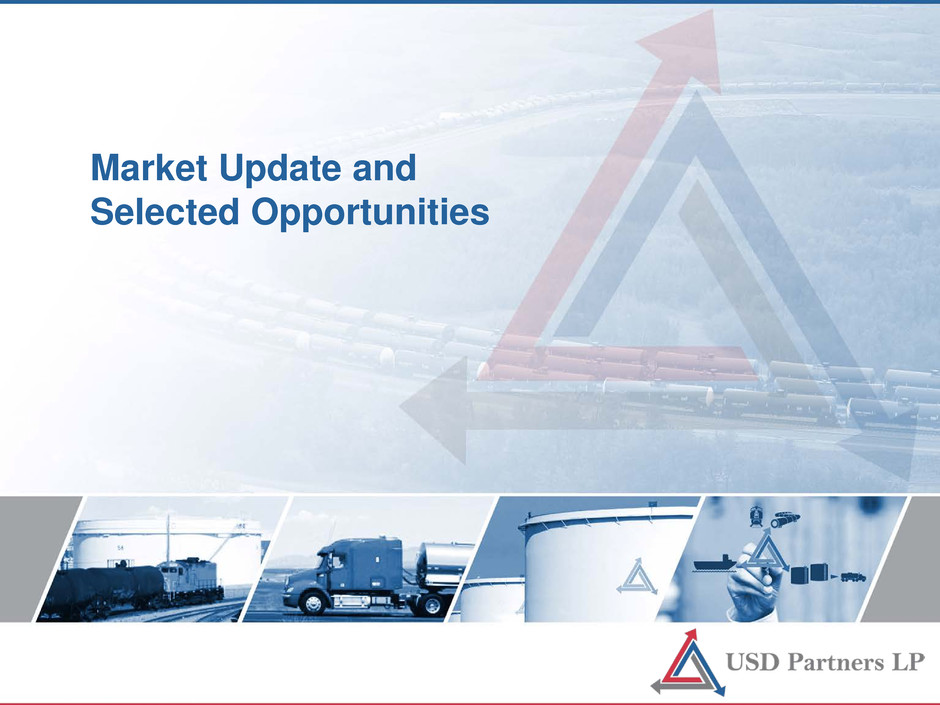
Market Update and Selected Opportunities
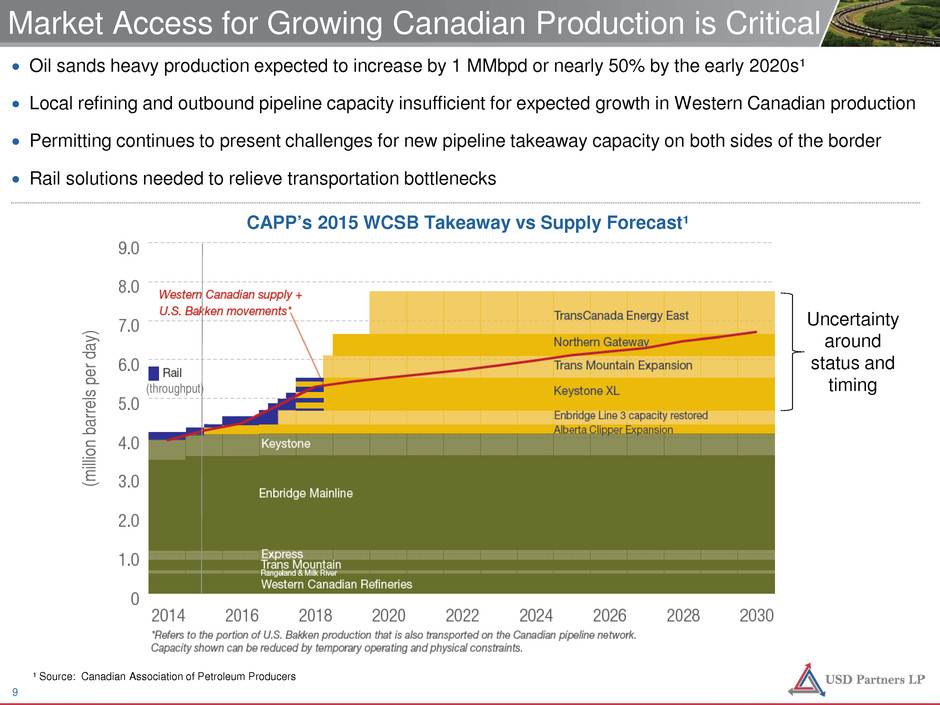
Market Access for Growing Canadian Production is Critical • Oil sands heavy production expected to increase by 1 MMbpd or nearly 50% by the early 2020s¹ • Local refining and outbound pipeline capacity insufficient for expected growth in Western Canadian production • Permitting continues to present challenges for new pipeline takeaway capacity on both sides of the border • Rail solutions needed to relieve transportation bottlenecks ¹ Source: Canadian Association of Petroleum Producers CAPP’s 2015 WCSB Takeaway vs Supply Forecast¹ (m illi on b ar re ls pe r d ay ) Uncertainty around status and timing(throughput) 9
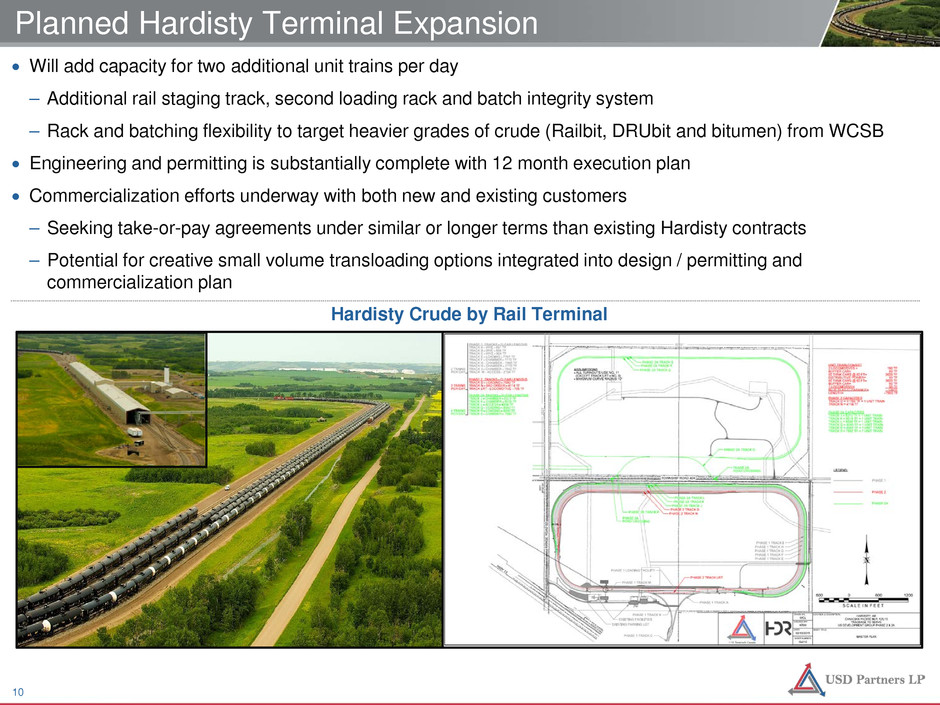
Planned Hardisty Terminal Expansion • Will add capacity for two additional unit trains per day – Additional rail staging track, second loading rack and batch integrity system – Rack and batching flexibility to target heavier grades of crude (Railbit, DRUbit and bitumen) from WCSB • Engineering and permitting is substantially complete with 12 month execution plan • Commercialization efforts underway with both new and existing customers – Seeking take-or-pay agreements under similar or longer terms than existing Hardisty contracts – Potential for creative small volume transloading options integrated into design / permitting and commercialization plan Hardisty Crude by Rail Terminal 10
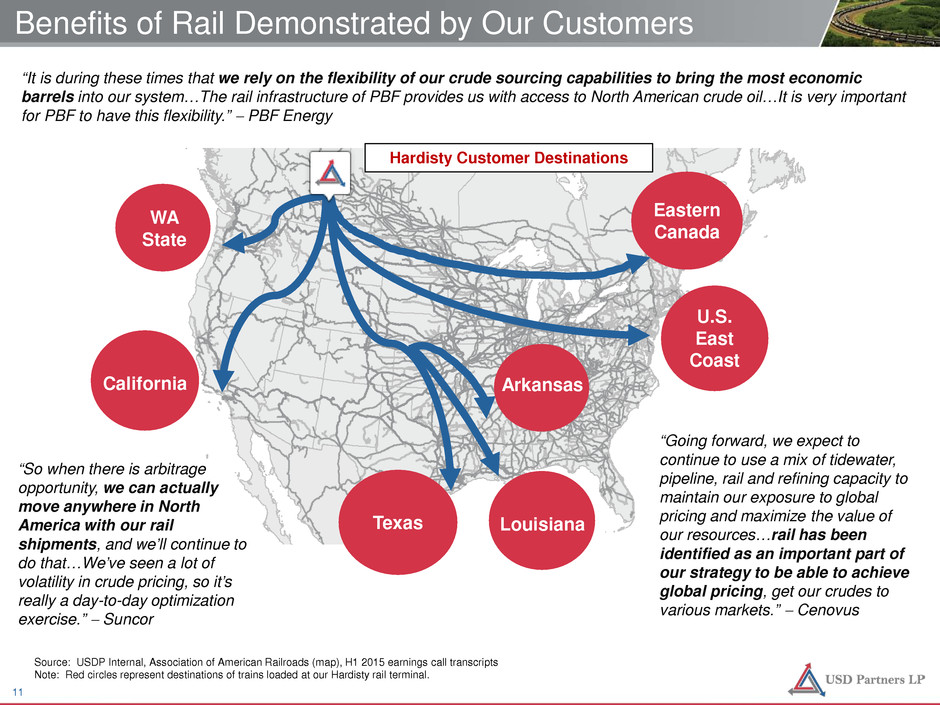
Benefits of Rail Demonstrated by Our Customers Source: USDP Internal, Association of American Railroads (map), H1 2015 earnings call transcripts Note: Red circles represent destinations of trains loaded at our Hardisty rail terminal. Eastern Canada U.S. East Coast WA State California Arkansas Texas Louisiana “So when there is arbitrage opportunity, we can actually move anywhere in North America with our rail shipments, and we’ll continue to do that…We’ve seen a lot of volatility in crude pricing, so it’s really a day-to-day optimization exercise.” − Suncor “It is during these times that we rely on the flexibility of our crude sourcing capabilities to bring the most economic barrels into our system…The rail infrastructure of PBF provides us with access to North American crude oil…It is very important for PBF to have this flexibility.” − PBF Energy “Going forward, we expect to continue to use a mix of tidewater, pipeline, rail and refining capacity to maintain our exposure to global pricing and maximize the value of our resources…rail has been identified as an important part of our strategy to be able to achieve global pricing, get our crudes to various markets.” − Cenovus Hardisty Customer Destinations 11
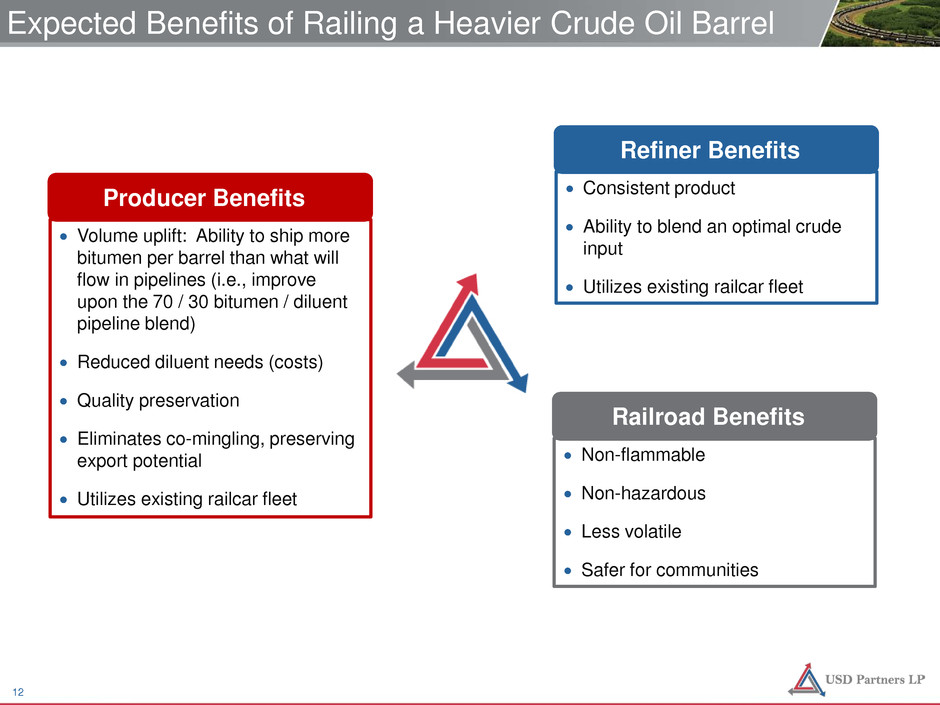
Expected Benefits of Railing a Heavier Crude Oil Barrel Producer Benefits • Volume uplift: Ability to ship more bitumen per barrel than what will flow in pipelines (i.e., improve upon the 70 / 30 bitumen / diluent pipeline blend) • Reduced diluent needs (costs) • Quality preservation • Eliminates co-mingling, preserving export potential • Utilizes existing railcar fleet Railroad Benefits • Non-flammable • Non-hazardous • Less volatile • Safer for communities Refiner Benefits • Consistent product • Ability to blend an optimal crude input • Utilizes existing railcar fleet 12
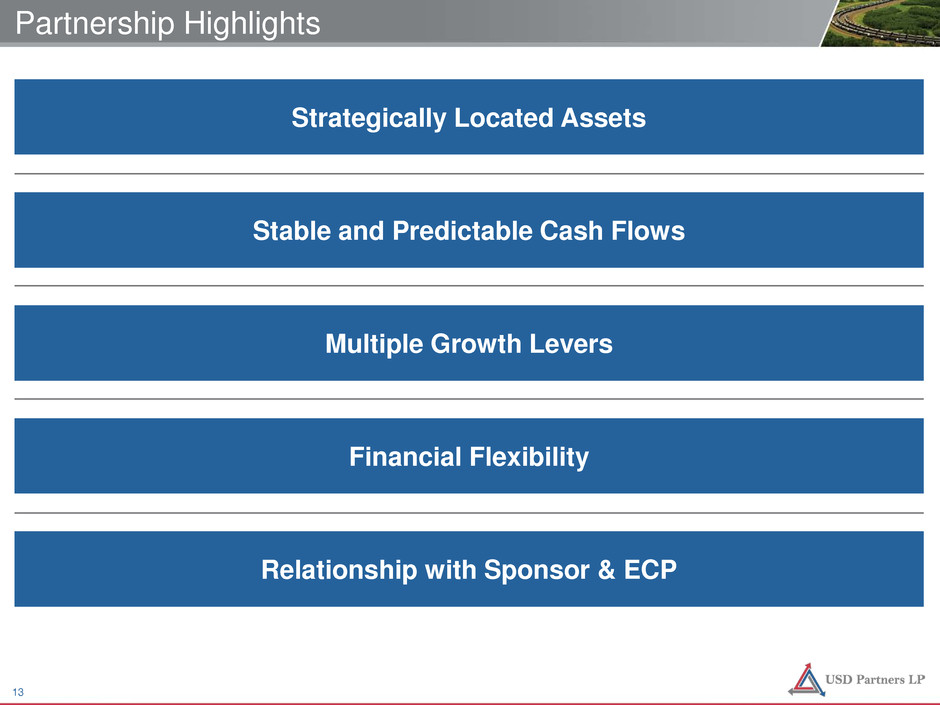
Partnership Highlights Relationship with Sponsor & ECP Strategically Located Assets Stable and Predictable Cash Flows Multiple Growth Levers Financial Flexibility 13
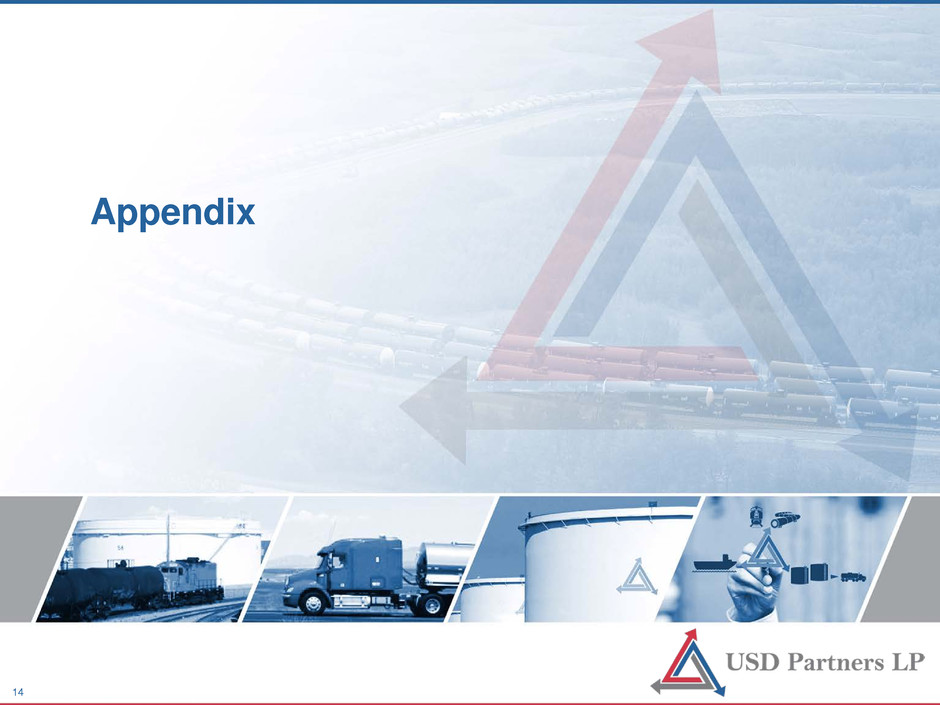
Appendix 14
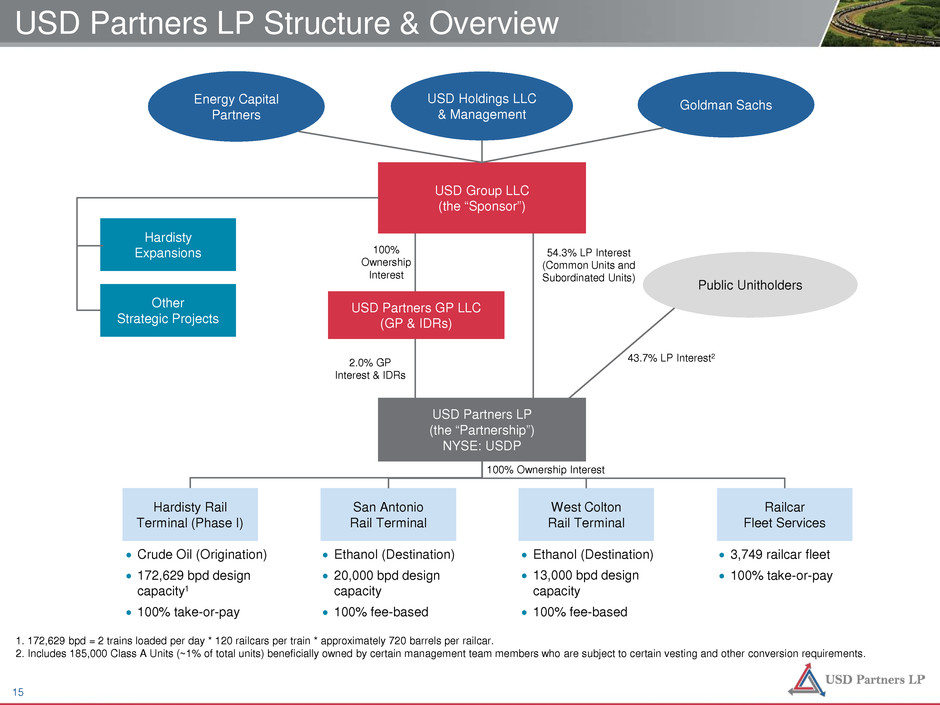
USD Partners LP Structure & Overview USD Group LLC (the “Sponsor”) USD Partners GP LLC (GP & IDRs) Public Unitholders Hardisty Rail Terminal (Phase I) San Antonio Rail Terminal West Colton Rail Terminal Railcar Fleet Services Hardisty Expansions 100% Ownership Interest 100% Ownership Interest 2.0% GP Interest & IDRs USD Partners LP (the “Partnership”) NYSE: USDP Other Strategic Projects Energy Capital Partners USD Holdings LLC & Management Goldman Sachs 54.3% LP Interest (Common Units and Subordinated Units) 43.7% LP Interest2 • Ethanol (Destination) • 20,000 bpd design capacity • 100% fee-based • Ethanol (Destination) • 13,000 bpd design capacity • 100% fee-based • 3,749 railcar fleet • 100% take-or-pay 1. 172,629 bpd = 2 trains loaded per day * 120 railcars per train * approximately 720 barrels per railcar. 2. Includes 185,000 Class A Units (~1% of total units) beneficially owned by certain management team members who are subject to certain vesting and other conversion requirements. • Crude Oil (Origination) • 172,629 bpd design capacity1 • 100% take-or-pay 15
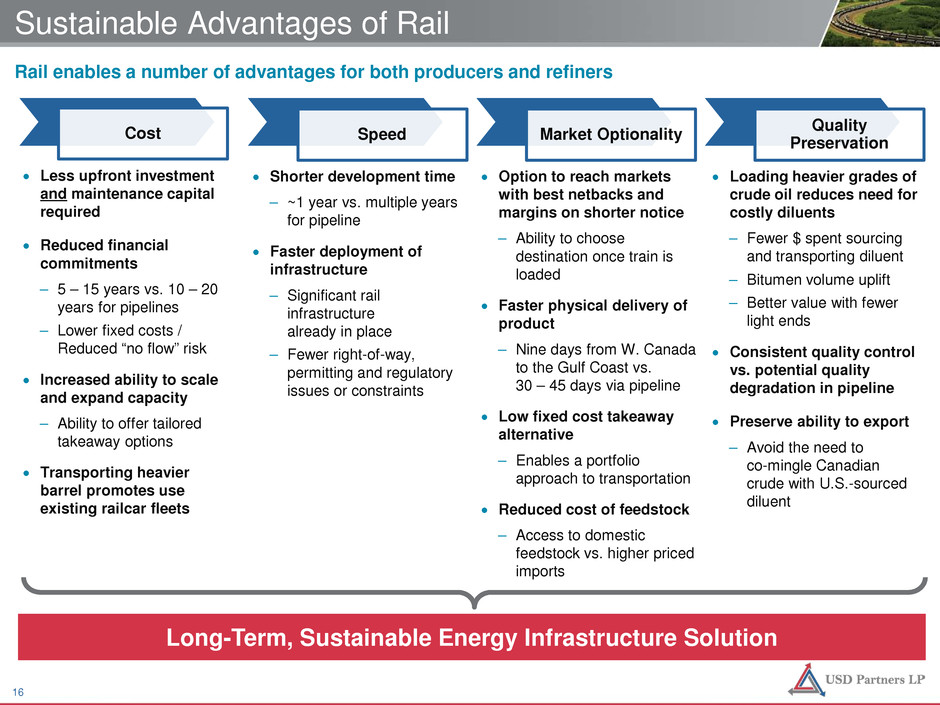
Rail enables a number of advantages for both producers and refiners Sustainable Advantages of Rail Long-Term, Sustainable Energy Infrastructure Solution Cost Speed Market Optionality Quality Preservation • Less upfront investment and maintenance capital required • Reduced financial commitments – 5 – 15 years vs. 10 – 20 years for pipelines – Lower fixed costs / Reduced “no flow” risk • Increased ability to scale and expand capacity – Ability to offer tailored takeaway options • Transporting heavier barrel promotes use existing railcar fleets • Shorter development time – ~1 year vs. multiple years for pipeline • Faster deployment of infrastructure – Significant rail infrastructure already in place – Fewer right-of-way, permitting and regulatory issues or constraints • Option to reach markets with best netbacks and margins on shorter notice – Ability to choose destination once train is loaded • Faster physical delivery of product – Nine days from W. Canada to the Gulf Coast vs. 30 – 45 days via pipeline • Low fixed cost takeaway alternative – Enables a portfolio approach to transportation • Reduced cost of feedstock – Access to domestic feedstock vs. higher priced imports • Loading heavier grades of crude oil reduces need for costly diluents – Fewer $ spent sourcing and transporting diluent – Bitumen volume uplift – Better value with fewer light ends • Consistent quality control vs. potential quality degradation in pipeline • Preserve ability to export – Avoid the need to co-mingle Canadian crude with U.S.-sourced diluent 16
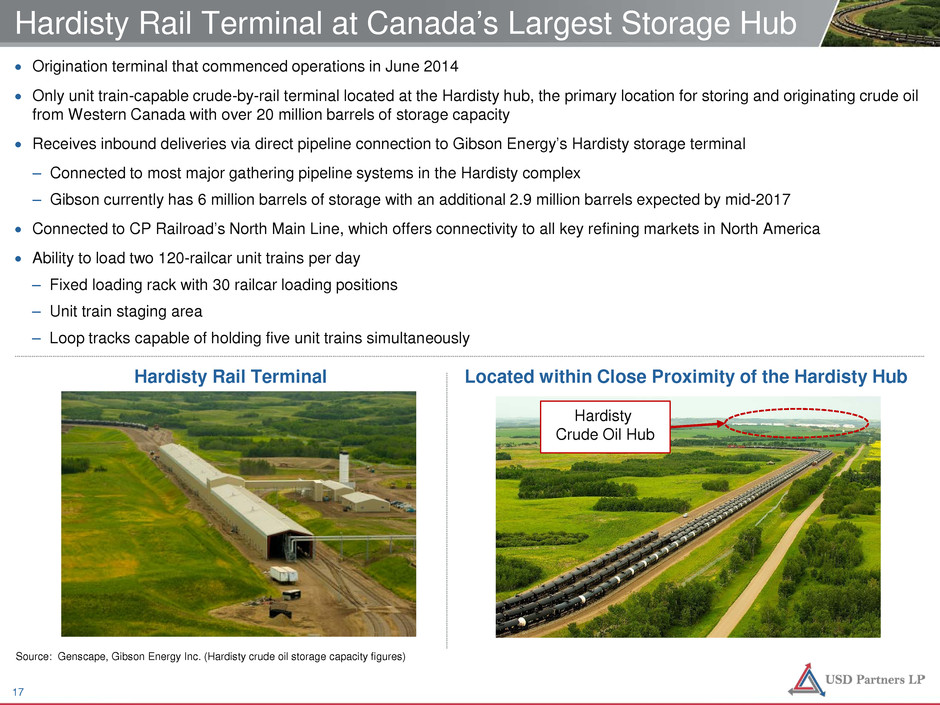
Hardisty Rail Terminal at Canada’s Largest Storage Hub • Origination terminal that commenced operations in June 2014 • Only unit train-capable crude-by-rail terminal located at the Hardisty hub, the primary location for storing and originating crude oil from Western Canada with over 20 million barrels of storage capacity • Receives inbound deliveries via direct pipeline connection to Gibson Energy’s Hardisty storage terminal – Connected to most major gathering pipeline systems in the Hardisty complex – Gibson currently has 6 million barrels of storage with an additional 2.9 million barrels expected by mid-2017 • Connected to CP Railroad’s North Main Line, which offers connectivity to all key refining markets in North America • Ability to load two 120-railcar unit trains per day – Fixed loading rack with 30 railcar loading positions – Unit train staging area – Loop tracks capable of holding five unit trains simultaneously Hardisty Rail Terminal Located within Close Proximity of the Hardisty Hub Hardisty Crude Oil Hub Source: Genscape, Gibson Energy Inc. (Hardisty crude oil storage capacity figures) 17
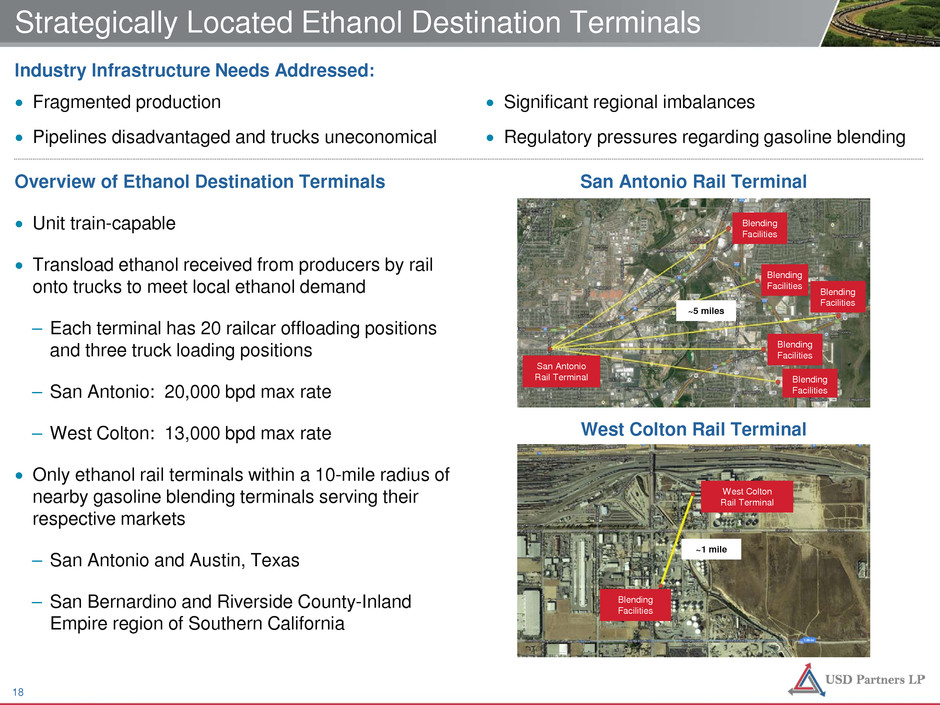
West Colton Rail Terminal Blending Facilities Strategically Located Ethanol Destination Terminals Industry Infrastructure Needs Addressed: • Fragmented production • Pipelines disadvantaged and trucks uneconomical • Significant regional imbalances • Regulatory pressures regarding gasoline blending Overview of Ethanol Destination Terminals • Unit train-capable • Transload ethanol received from producers by rail onto trucks to meet local ethanol demand – Each terminal has 20 railcar offloading positions and three truck loading positions – San Antonio: 20,000 bpd max rate – West Colton: 13,000 bpd max rate • Only ethanol rail terminals within a 10-mile radius of nearby gasoline blending terminals serving their respective markets – San Antonio and Austin, Texas – San Bernardino and Riverside County-Inland Empire region of Southern California San Antonio Rail Terminal San Antonio Rail Terminal Blending Facilities Blending Facilities Blending Facilities Blending Facilities Blending Facilities West Colton Rail Terminal ~1 mile ~5 miles 18
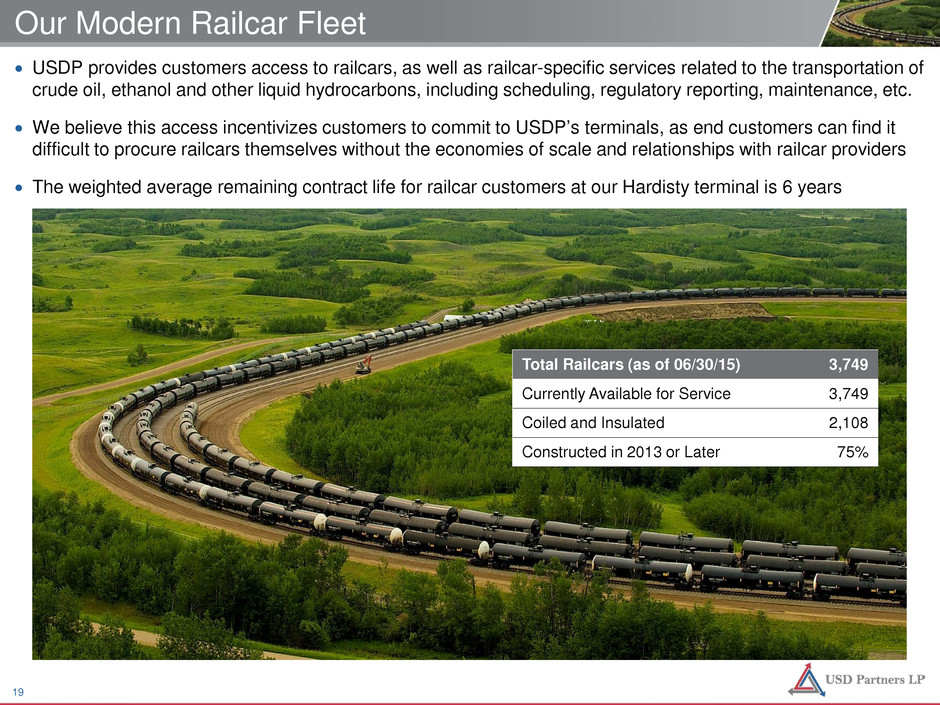
• USDP provides customers access to railcars, as well as railcar-specific services related to the transportation of crude oil, ethanol and other liquid hydrocarbons, including scheduling, regulatory reporting, maintenance, etc. • We believe this access incentivizes customers to commit to USDP’s terminals, as end customers can find it difficult to procure railcars themselves without the economies of scale and relationships with railcar providers • The weighted average remaining contract life for railcar customers at our Hardisty terminal is 6 years Our Modern Railcar Fleet Total Railcars (as of 06/30/15) 3,749 Currently Available for Service 3,749 Coiled and Insulated 2,108 Constructed in 2013 or Later 75% 19
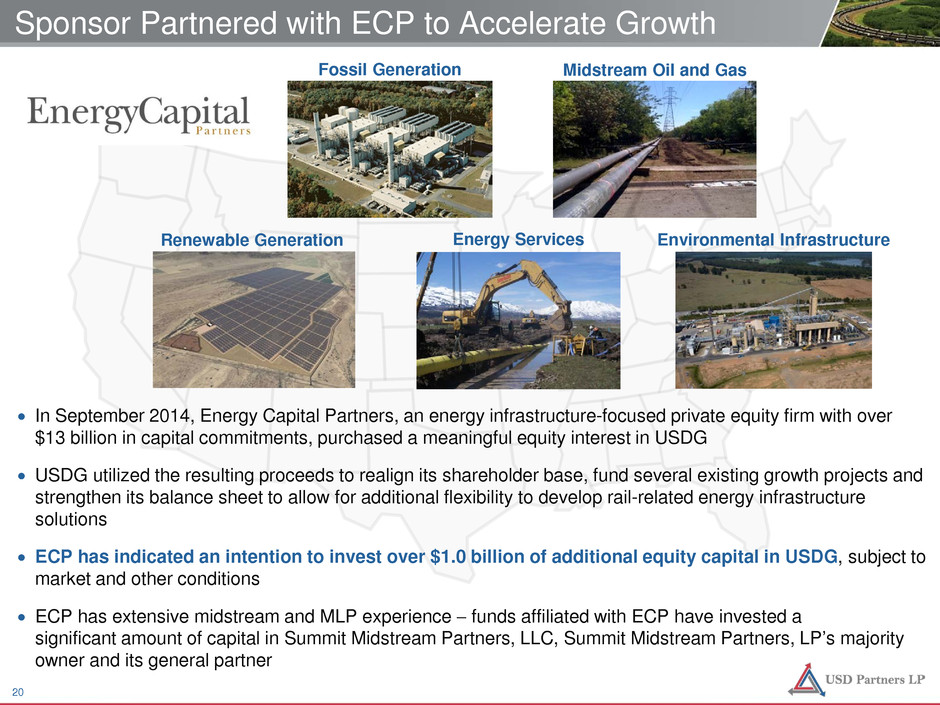
• In September 2014, Energy Capital Partners, an energy infrastructure-focused private equity firm with over $13 billion in capital commitments, purchased a meaningful equity interest in USDG • USDG utilized the resulting proceeds to realign its shareholder base, fund several existing growth projects and strengthen its balance sheet to allow for additional flexibility to develop rail-related energy infrastructure solutions • ECP has indicated an intention to invest over $1.0 billion of additional equity capital in USDG, subject to market and other conditions • ECP has extensive midstream and MLP experience − funds affiliated with ECP have invested a significant amount of capital in Summit Midstream Partners, LLC, Summit Midstream Partners, LP’s majority owner and its general partner Sponsor Partnered with ECP to Accelerate Growth Midstream Oil and GasFossil Generation Renewable Generation Environmental InfrastructureEnergy Services 20
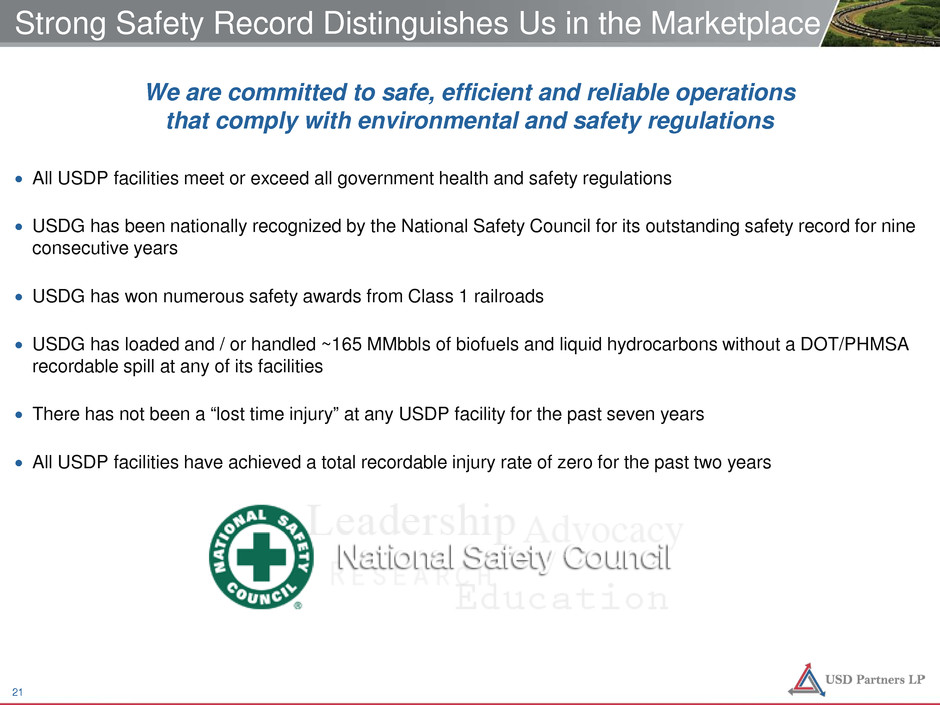
We are committed to safe, efficient and reliable operations that comply with environmental and safety regulations • All USDP facilities meet or exceed all government health and safety regulations • USDG has been nationally recognized by the National Safety Council for its outstanding safety record for nine consecutive years • USDG has won numerous safety awards from Class 1 railroads • USDG has loaded and / or handled ~165 MMbbls of biofuels and liquid hydrocarbons without a DOT/PHMSA recordable spill at any of its facilities • There has not been a “lost time injury” at any USDP facility for the past seven years • All USDP facilities have achieved a total recordable injury rate of zero for the past two years Strong Safety Record Distinguishes Us in the Marketplace 21
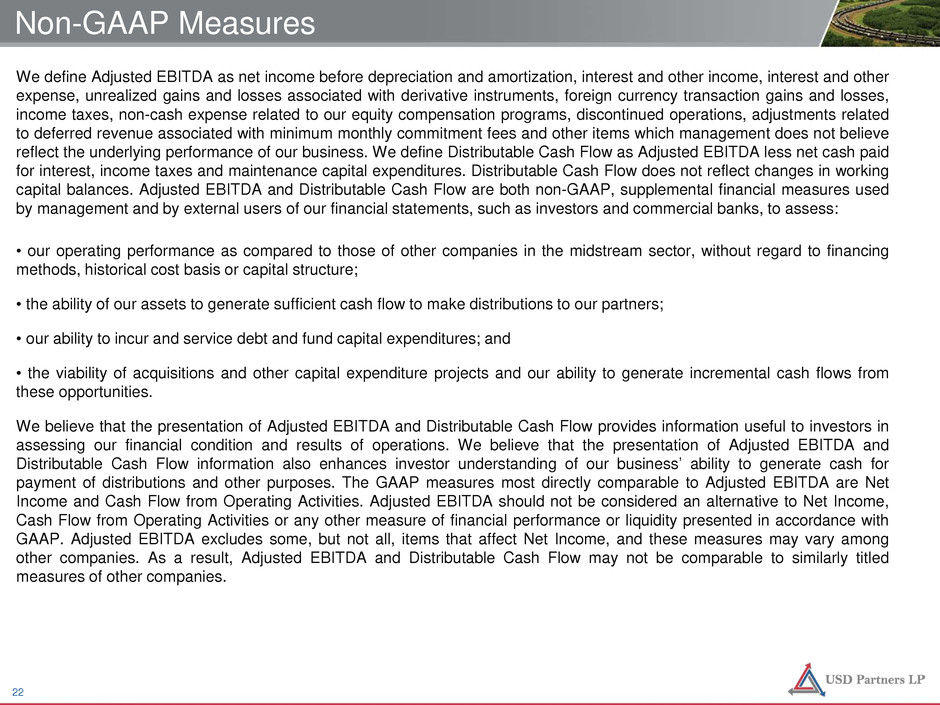
Non-GAAP Measures We define Adjusted EBITDA as net income before depreciation and amortization, interest and other income, interest and other expense, unrealized gains and losses associated with derivative instruments, foreign currency transaction gains and losses, income taxes, non-cash expense related to our equity compensation programs, discontinued operations, adjustments related to deferred revenue associated with minimum monthly commitment fees and other items which management does not believe reflect the underlying performance of our business. We define Distributable Cash Flow as Adjusted EBITDA less net cash paid for interest, income taxes and maintenance capital expenditures. Distributable Cash Flow does not reflect changes in working capital balances. Adjusted EBITDA and Distributable Cash Flow are both non-GAAP, supplemental financial measures used by management and by external users of our financial statements, such as investors and commercial banks, to assess: • our operating performance as compared to those of other companies in the midstream sector, without regard to financing methods, historical cost basis or capital structure; • the ability of our assets to generate sufficient cash flow to make distributions to our partners; • our ability to incur and service debt and fund capital expenditures; and • the viability of acquisitions and other capital expenditure projects and our ability to generate incremental cash flows from these opportunities. We believe that the presentation of Adjusted EBITDA and Distributable Cash Flow provides information useful to investors in assessing our financial condition and results of operations. We believe that the presentation of Adjusted EBITDA and Distributable Cash Flow information also enhances investor understanding of our business’ ability to generate cash for payment of distributions and other purposes. The GAAP measures most directly comparable to Adjusted EBITDA are Net Income and Cash Flow from Operating Activities. Adjusted EBITDA should not be considered an alternative to Net Income, Cash Flow from Operating Activities or any other measure of financial performance or liquidity presented in accordance with GAAP. Adjusted EBITDA excludes some, but not all, items that affect Net Income, and these measures may vary among other companies. As a result, Adjusted EBITDA and Distributable Cash Flow may not be comparable to similarly titled measures of other companies. 22

Adjusted EBITDA and DCF Reconciliation 23
